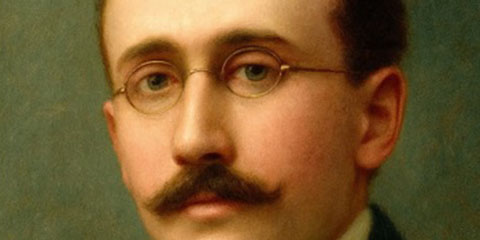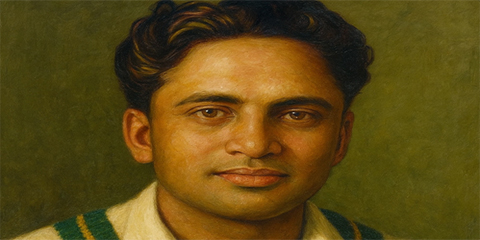How F. S. Ashley-Cooper wrote 40,000 cricket obituaries and saved the game's Edwardian heritage
JournalismPakistan.com | Published last month | Dr. Nauman Niaz (TI)
Join our WhatsApp channel
ISLAMABAD— If the world were ever generous enough to grant me the gift of a time machine, I know I would not point its compass to the gleaming future, to flying cars or glassy towers, but to the past, to an era that feels less like a date in a history book and more like the pulse of some long, sweet music.
I would set its dial back to Edwardian England, back to summers where the air itself seemed scented with cricket, where civilisation paused for the thud of ball on bat, where afternoons stretched like novels and the game was not just played but enacted as a ritual, a social performance, a cultural expression.
Meeting Cricket's Immortals: From W.G. Grace to Victor Trumper
How greedily, how reverently, would I seek out its immortals. Billy Murdoch, colonial and unbending, a man with the bearing of empire in his stance. W. G. Grace, of course, with his biblical beard, an Old Testament patriarch who was not so much a cricketer as cricket itself given human form.
Archie MacLaren, aristocrat of poise and stroke, batting not to score runs but to produce silhouettes of elegance. And Victor Trumper, most fleeting, most eternal of them all, a man who batted as if sunlight had chosen him as its medium. I would hope to arrive on the day Archie Jackson, boy-poet of the crease, made his Test debut, each stroke seeming a prophecy. And in a quieter hour, what delight to hold the hand of Kumar Shri Ranjitsinhji, the princely genius who turned the bat into a brush and the pitch into a canvas.
The True Pilgrimage: Finding Cricket's Greatest Archivist
Yet most of all, I confess, my pilgrimage would lead me elsewhere, not to the crease, but to the library. For it is there that one would find F. S. Ashley-Cooper, hunched, bespectacled, a monastic figure, not so much watching cricket as saving it, ensuring that its spirit did not evaporate into the forgetfulness of time.
Frederick Samuel Ashley-Cooper: The Man Who Couldn't Play But Saved the Game
Frederick Samuel Ashley-Cooper was born in Bermondsey in 1877. He never played Test cricket, never thrilled a crowd with a boundary, never so much as became a regular club player. Poor eyesight and frail health condemned him early to the peripheries. But fate, in its strange generosity, compensated him with a vision of another kind: the ability to see cricket's past, to see how fragile it was, how easily lost, how desperately in need of preservation.
Where others saw scorecards, he saw scripture. Where others noticed averages, he saw elegies. His was the paradoxical glory of a man who, denied the sight of the game in full bloom, became its eternal custodian. He did not play the game on the field, but he played it on the page, and in so doing, granted cricket a kind of immortality no innings, however great, could achieve.
Transforming Wisden: From Two Pages to a Cathedral of Cricket Records
Ashley-Cooper turned Wisden's modest 'Records' section, once barely two pages, into a cathedral of sixty-one. By the time he was done, every statistic had been chiseled with the reverence of an inscription on stone. He wrote no fewer than 103 books and pamphlets, and 40,000 obituaries and biographical sketches. Forty thousand! Imagine the patience, the devotion, the sheer fidelity it required. Each was a tiny resurrection, a chance to grant immortality to men who might otherwise have disappeared like chalk scores washed away by rain.
At his death in 1932, Wisden itself bowed in gratitude, calling him a great authority and prolific chronicler. The Times praised him as one of cricket's most authoritative voices. Yet those phrases, though true, feel inadequate. His achievement was not simply academic; it was cultural. He preserved an entire age.
The Edwardian Era: Cricket's Eternal Afternoon
To speak of the Edwardian era is to conjure not only a time but a mood. It was short, barely a decade between Queen Victoria's death in 1901 and the outbreak of war in 1914, but in memory it has become an eternal afternoon. Straw boaters, parasols, lazy county grounds where the game unrolled at a pace in keeping with the rhythm of life itself. It was a society poised between Victorian certainty and modern uncertainty, between empire's confidence and war's catastrophe.
Cricket was its mirror, its theatre, its solace. Matches were stages on which imperial virtues were performed. W.G. Grace, Kumar Ranjitsinhji, VictorTrumper, they were not just cricketers but cultural symbols, embodiments of Edwardian grace, style, even contradiction. To watch them was to watch England, and to imagine the world it ruled.
Capturing Memory: How Ashley-Cooper Froze the Ephemeral Into Fact
And here enters Ashley-Cooper. While poets like Neville Cardus would later capture the mood, Ashley-Cooper captured the memory. He gave the Edwardian game permanence, ensuring it would not dissolve into myth or nostalgia. Through his works, Sussex Cricket and Cricketers, Curiosities of First-Class Cricket, Nottinghamshire Cricket and Cricketers, he froze the ephemeral into fact, yet without killing its essence.
In his hands, the Edwardian age became more than a sepia photograph. It became accessible. His records allowed later generations to reconstruct it, to touch its texture, to understand its rhythms. He gave us not merely runs and wickets, but the ancestry of cricket itself.
The Sacred Relics: Ashley-Cooper Books as Cricket's Fabergé Eggs
To own an Ashley-Cooper book is to hold more than paper. It is to clasp the fragrance of cricket's youth. His works, hand-signed, are like relics from a vanished cathedral. Auction houses whisper his name; collectors measure authenticity against his meticulous catalogues. His bibliographies and compilations became anchors for cricket's fragile world of memorabilia.
He did not just write; he curated. He edited earlier works, republished Pycroft's The Cricket Field, compiled lists, indexes, and statistical tables. He was less a literary stylist than a watchman, less a romantic than a conservator. And yet, paradoxically, this very sobriety became his poetry. For what is poetry if not the act of rescuing meaning from oblivion?
The Foundation of Cricket Collecting: Ashley-Cooper's Enduring Scaffolding
Today, when cricket books appear in rare auctions, Ashley-Cooper's fingerprints are everywhere. His catalogues guide provenance; his reconstructions establish rarity. The modern world of cricket collecting rests on the scaffolding he built.
A Lost Legacy in Pakistan: The Ghost Unknown to Cricket Lovers
And yet, in Pakistan, I suspect few know his name. Perhaps Qamar Ahmed, with his encyclopedic memory, or Chisty Mujahid, who carried the tradition and beliefs of the game, may have heard of him. But to the wider world here, Ashley-Cooper is an unknown ghost. Few have read him; fewer still own him. And that is a loss.
A library of cricket cannot be complete without a couple of Ashley-Coopers upon its shelves. His works are Fabergé eggs of cricket literature: rare, costly, exquisite. There are fewer books than talismans, fewer statistics than culture. To own one is to own a piece of cricket's lineage.
Cricket's Detective: Resurrecting Lost Matches and Forgotten Players
Ashley-Cooper was more than a compiler. He was cricket's detective, its archaeologist. He burrowed into club records, minute books, and faded newspapers. He reconstructed lost matches, reconciled conflicting scorecards, and revived forgotten players. His Hambledon Cricket Chronicle is not only history but a resurrection. It makes the long-dead players of that village, cradle of the game, walk again, their flannels white against the Hampshire sun.
He did not romanticise, but neither did he sterilise. His devotion was to accuracy, but accuracy in his hands did not dry out; it glowed. He granted cricket its continuity, ensuring that the modern game could trace its ancestry back, unbroken, to Hambledon, to the 18th century, to the game's very dawn.
The Bridge Between Centuries: Ashley-Cooper's Timeless Legacy
Ashley-Cooper's legacy is not measured in style but in endurance. He preserved cricket's Edwardian glow more surely than any cover drive. He gave the game its lineage, its ancestry, its memory. His greatness lies not in the words he wrote, but in the fact that, without him, the game itself would be an orphan. He stands as a bridge: between Hambledon and Headingley, between Grace and Jardine, between the whispers of the 18th century and the roars of the 20th. To read him is to hear, faint but clear, the applause of a vanished crowd.
Some men played the game, and others gave it words. Ashley-Cooper belonged to neither camp fully, and yet belonged to cricket more deeply than most. He was not a cricketer, not a poet, but a custodian. He chiselled away forgetfulness and restored memory. He ensured that the Edwardian age, quizzical, enthralling, full of wonder, did not fade. Through him, cricket lingers on, like the afterglow of a long summer's evening.
Dr. Nauman Niaz is a civil award winner (Tamagha-i-Imtiaz) in Sports Broadcasting & Journalism, and is the sports editor at JournalismPakistan.com. He is a regular cricket correspondent, having covered 54 tours and three ICC World Cups, and having written over 3500 articles. He has authored 15 books and is the official historian of Pakistan Cricket (Fluctuating Fortunes IV Volumes - 2005). His signature show, Game On Hai, has been the highest in ratings and acclaim.

























